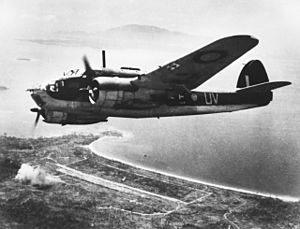No. 8 Squadron RAAF facts for kids
Quick facts for kids No. 8 Squadron RAAF |
|
|---|---|

A No. 8 Squadron Beaufort during an attack on Wewak in 1944
|
|
| Active | 1917–1919 1940–1942 1943–1946 |
| Country | Australia |
| Branch | Australian Flying Corps Royal Australian Air Force |
| Engagements | World War I World War II |
No. 8 Squadron was an Australian air force unit. It was a training squadron during World War I. Later, it became a bomber squadron in World War II. The squadron first formed in England in October 1917. It was part of the Australian Flying Corps. It stopped operating in April 1919. The squadron started again in September 1939. This time, it was part of the Royal Australian Air Force. It fought in the Pacific War. They flew Lockheed Hudson and DAF Beaufort bomber planes. The squadron was then stopped for good in January 1946.
Contents
A Brief History of No. 8 Squadron
World War I: Training Pilots
No. 8 Squadron first started during World War I. It was a flying training squadron. This means it taught new pilots how to fly. It was formed on October 25, 1917, in Yatesbury, England. This squadron was part of the Australian Flying Corps.
The squadron got its first planes in January 1918. They trained pilots to replace those fighting in No. 4 Squadron. After World War I ended, No. 8 Squadron was stopped on April 30, 1919.
World War II: Early Days and First Battles
No. 8 Squadron started again during World War II. It became a bomber and reconnaissance unit. This means it flew planes to drop bombs and gather information. It reformed on September 11, 1939, in Canberra, Australia.
At first, the squadron used DC-3 transport planes. These were civilian planes used for patrols along the Australian coast. They also helped with transport tasks. In May 1940, the squadron received Lockheed Hudson medium bombers.
Fighting in the Pacific War
In August 1940, No. 8 Squadron moved to Singapore. They saw their first action when the war in the Pacific began. This was in December 1941. Their 12 planes attacked Japanese ships near Malaya.
The squadron lost many planes and airmen. This was due to anti-aircraft fire and Japanese fighter planes. They flew bombing and reconnaissance missions during the Malayan Campaign. Because they lost so many planes, No. 8 Squadron joined with No. 1 Squadron in December.
The combined squadron kept fighting. In January 1942, No. 8 Squadron gave its remaining Hudson planes to No. 1 Squadron. Its members then went to Palembang in Sumatra. There, they received new Hudson planes. These planes came from No. 59 Squadron RAF in the UK. The squadron continued its missions. They kept losing planes and airmen. No. 8 Squadron was stopped again on February 16, 1942. Its members returned to Australia.
World War II: Later Operations
No. 8 Squadron started for a third time on March 12, 1943. It was reformed in Canberra. This time, they flew DAP Beaufort planes. These were medium and torpedo bombers. They practiced flying, bombing, and air-to-air gunnery. They also trained with torpedoes at Jervis Bay.
In July 1943, the squadron moved to northern Queensland. Then, in September, they moved to Goodenough Island in Papua New Guinea. From there, they began combat missions. They attacked Japanese airfields, supply areas, and ships near New Britain.
Important Missions and End of War
In December 1943, one of their planes sank a large Japanese ship. It was 6,834 tonnes and was sunk with torpedoes in Simpson Harbour. After the Japanese base at Rabaul was cut off, the squadron moved. They went to the New Guinea mainland in April 1944.
From bases near Nadzab and Tadji, they attacked Japanese positions. They flew strikes near Wewak and patrolled for enemy ships. They continued these missions until the war ended. No. 8 Squadron was finally stopped for good on January 19, 1946, in New Guinea.
During the war, 79 people from the squadron died while serving.
Aircraft Flown by No. 8 Squadron
No. 8 Squadron used different types of aircraft over the years:
- Avro 504 (January 1918 – April 1919)
- Sopwith Pup (January 1918 – April 1919)
- Sopwith Camel (January 1918 – April 1919)
- Sopwith Snipe (?-April 1919)
- Douglas DC-2 (September 1939 – May 1940)
- Douglas DC-3 (September 1939 – May 1940)
- Lockheed Hudson (May 1940 – February 1942)
- DAP Beaufort (March 1943 – January 1946)
Images for kids


